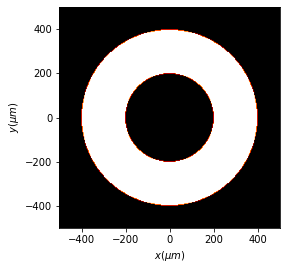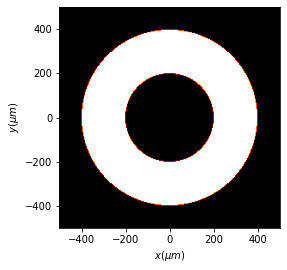1. Developing new functions
Sometimes we need to generate new functions for the modules. For development purposes, new functions can be generated in jupyter and included in a module as if they were inside the module: - Create the function to test. - Make the first argument of the function: self - Return the same value: self - When calling the function: u1=function_new(u1,…)
[1]:
from diffractio import np, plt, sp, um, mm, degrees, nm
from diffractio.scalar_masks_XY import Scalar_mask_XY
[2]:
x0 = np.linspace(-500 * um, 500 * um, 256)
y0 = np.linspace(-500 * um, 500 * um, 256)
wavelength = 0.6328 * um
1.1. Standard procedure
[3]:
u0 = Scalar_mask_XY(x0, y0, wavelength)
u0.ring(r0=(0, 0), radius1=200 * um, radius2=400 * um, angle=0 * degrees)
u0.draw()

This function, inside diffractio is:
[ ]:
def ring(self, r0, radius1, radius2, angle=0 * degrees):
""" Ring.
Parameters:
r0 (float, float): center of ring
radius1 (float, float) or (float): inner radius
radius2 (float, float) or (float): outer radius
angle (float): angle of rotation in radians
"""
ring1 = Scalar_mask_XY(self.x, self.y, self.wavelength)
ring2 = Scalar_mask_XY(self.x, self.y, self.wavelength)
ring1.circle(r0, radius1, angle)
ring2.circle(r0, radius2, angle)
self.u = ring2.u - ring1.u
1.2. Development Mode
[4]:
def ring_new(self, r0, radius1, radius2, angle=0 * degrees):
""" Ring.
Parameters:
r0 (float, float): center of ring
radius1 (float, float) or (float): inner radius
radius2 (float, float) or (float): outer radius
angle (float): angle of rotation in radians
"""
ring1 = Scalar_mask_XY(self.x, self.y, self.wavelength)
ring2 = Scalar_mask_XY(self.x, self.y, self.wavelength)
ring1.circle(r0, radius1, angle)
ring2.circle(r0, radius2, angle)
self.u = ring2.u - ring1.u
print("I am in the new function")
return self
[5]:
# Now it works as if it were inside Scalar_mask_XY
u1 = Scalar_mask_XY(x0, y0, wavelength)
u1 = ring_new(u1,
r0=(0, 0),
radius1=200 * um,
radius2=400 * um,
angle=0 * degrees)
u1.draw()
I am in the new function

[ ]: